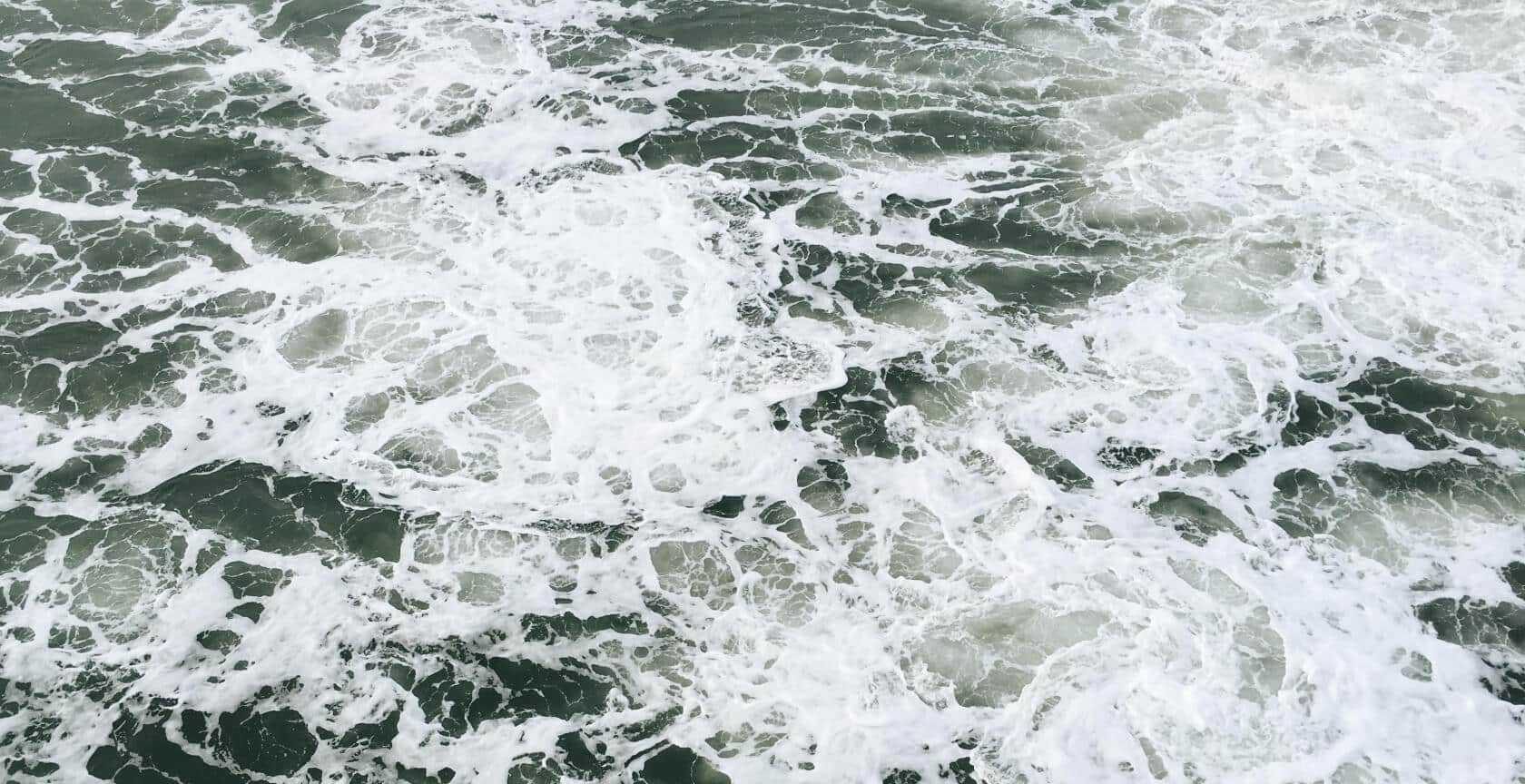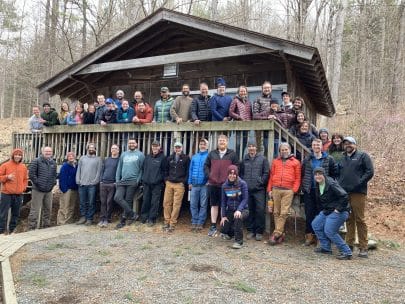An effective rescue needs all the right tools, knowledge and experience. While learning how to use the equipment in a river rescue course is critical to being an effective rescuer, there are a few key pieces of gear that can make your job easier and safer. Among these, one that is most often overlooked is a piece of one inch tubular webbing. 20 feet is generally about the right length for most uses and can be tied in a loop and worn as a belt attached by a locking carabiner in front.
Here are just a few uses for the webbing belt:
An anchor for z-drags and pinned boats
There are many objects alongside a river that can be used to make an anchor. Live trees that are at least six inches in diameter can be wrapped with webbing to make a great anchor. Also keep an eye out for large boulders or cracks between boulders that webbing could pass around or through. A knot made in webbing can also be chocked into a narrowing crack to create another anchor point.
There are a number of different ways to attach webbing to an anchor but the main goal is the same: create a strong anchor. The anchor should not budge with a strong push or pull. Anchors and webbing may need to sustain large forces, often over a thousand pounds of pressure with a mechanical advantage rescue. Tying webbing to the base of the anchor provides the strongest support. In some situations a higher anchor point will change the angle of pull on a pinned object. Keeping the carabiners off the anchor and suspended in the air prevents cross loading on them which could cause failure.
Both ends of a tensioned system can be anchored with webbing. When dealing with a pinned boat its best not to attach carabiners directly to grab loops. Doing so can result in broken carabiners or grab loops that could pop off and go flying if under tension. Instead, tie webbing or a prussik loop around the seat or grab loops of a pinned boat to reduce the risk of overstressing the system. Multiple anchor points can also reduce the stress on each point, creating a stronger system. A climbing course or river rescue course is a good place to learn techniques to attach webbing to multiple parts of a shoreline or boat.
A zip line for quick river crossings
A zip line allows many paddlers to cross a river very quickly. To set up a zip line first throw a rope across the current that needs to be crossed. Walk one end farther downstream, and then anchor both sides. Now attach a carabiner to a piece of webbing and clip this to the upstream side of the throw rope that is across the current. Anybody can then lay on their back holding the webbing and the current will slide them down the rope and across the river. A retrieval line can be attached to the carabiner so multiple people will be able to use the zip line using a single carabiner and piece of webbing. Attach the retrieval line to the carabiner and webbing and then pull the carabiner and webbing back after each person slides across.
A hand line for difficult scouts
Scouting a rapid can often be more treacherous then running the rapid. Many injuries happen to paddlers from slips and falls on shore while scouting. On a steep shoreline you can use webbing to set up a hand line for additional support in a particularly slippery area. To do this, have the first boater across the slope attach one end of the webbing to an anchor and then carefully traverse horizontally to another anchor. After the leader has secured the webbing to the second anchor, other group members will be able to use the webbing to cross more easily. A harness in conjunction with a hand line can allow a paddler to be clipped into the webbing and climb hands-free in a treacherous area. This can also allow paddlers to be anchored in for throw bag tosses.
A harness
Learning to make a quick harness out of webbing can be useful in a difficult shoreline rescue. Before you use this technique in a real rescue situation, it’s important to understand that this is essentially a climbing technique since you may be supporting your entire body weight on the harness. This technique should be done with the same level of care and training that all climbing involves.To make a basic webbing harness, also known as a “Swiss Seat”, first tie two leg loops into the middle of a twenty foot strand of webbing with the loops about six inches apart from each other. Then step into the leg loops. Wrap the side strands all the way behind your back and then up to the front. Feed the side strands through the front area that comes down the legs and then back to the same side all the way behind your back again. Bring them around your back to the front and tie off the waist portion with a square knot backed up with an overhand knot on each side.A correctly tied webbing harness with leg loops and a waist belt is suitable for vertical to overhanging terrain. A waist belt might be all that is needed for a steep shoreline rescue.
A six handled litter
In an evacuation situation a twenty foot strand of webbing can make a convenient six handled litter. This is not suitable for a patient with a potential spine injury, but works well when this is not a concern.
To make the litter start with the webbing tied into a large loop; then make two twists and spread it out on the ground. It should look like two figure eights, or three spots to hold onto on each side. For more support or stability add paddles or branches. Pad the litter to help keep the patient more comfortable.
A flip line for rafts
If a raft flips, attach webbing to one side and throw it over the top of the raft. Then the rescuer can go on top of the upside down raft. They will hold the webbing and lean back until the raft flips back over. Fall into a back flop to avoid your feet hitting the ground. Using the same technique, a second swimmer can get pulled into the raft as it gets righted by using a second webbing line. The rescuer climbs on top of the upside down raft and begins to right it. The second swimmer waits in the water until the raft is pulled about vertical. Then as the raft begins to fall they will hold onto the webbing and get pulled out of the water and into the raft. They can then help the first rescuer back in the raft.
A quick short reach device
Webbing can be used as a throw rope for someone that is a short distance away. Throw bags have the potential of getting stuck in rapids and can become an added danger. If extra distance isn’t needed a piece of extended webbing may reach a troubled paddler with less risk of getting stuck. An added benefit is that webbing can be put away much more quickly afterwards.
A tow tether
A tow tether is a great addition to a rescue vest but usually must be purchased separately. It is a short piece of webbing or bungeed webbing that can help tow boats. The tow tether is great because the boat is attached to the vest but can be quickly released if needed. Having it attached to the vest allows the paddler to maneuver more easily. It works best when the kayak being rescued is emptied out so that it will pull easily through the water. A webbing shoulder sling also works for towing boats. For a shoulder sling have the webbing in a large loop and attach one end to the boat. Then drape the other end over your shoulder. Never tie into an object that is being towed, because of the risk of capsizing or getting pulled toward a hazard. Always look downstream before towing to ensure that you won’t be pulled into another rapid, dragged around the wrong side of a rock or sucked into any other river hazard.
For dragging a boat
For long portages it is often easier to drag a plastic whitewater kayak than it is to carry it. Boats that are heavily loaded with gear are also sometimes too heavy to pick up, so they must be dragged. Dragging works well on inactive railroads and surfaces that aren’t too abrasive. The surface also determines how difficult it will be to drag your boat. Avoid dragging boats on pavement and rocks that are like pavement since these can quickly wear away a kayak. To drag a boat, attach your webbing strap to the grab loop on one end, and connect the other end to the puller’s waist. Padding around the waist helps for long walks.
A way to keep the kayak near the shore
Exiting from a kayak onto shore can sometimes be a tricky proposition when there are swirly currents. One way to prevent the boat from floating downstream is to attach a piece of webbing to it and hold onto the other end. This way the boat will be controlled during the exit on the way up the shoreline. It is embarrassing to have a kayak run a rapid without you.
An extra step to get back in rafts or canoes
Secure webbing to a thwart and then tie a loop about one foot into the water. Then use the loop as a step to assist the swimmer out of the water and back into the right side up raft or canoe.
The top of a shelter
To create a makeshift shelter, tie up some webbing like a clothesline and then drape a tarp or a bunch of branches over it. Use rocks, paddles, webbing, forest items and other tools that are often carried while paddling to create a unique shelter that suits the predicament. Shelters are great for a nice break on the river, or planned / unplanned overnight stays.
So, don’t leave the webbing at home on your next paddling venture. Practice using it during a river rescue course, climbing course or wilderness medical training. Also, practice rescue techniques with the group of friends that you paddle with. Treat it like a valued piece of gear. Keep river rescue gear up to date and check it periodically for weakness. UV sunrays reduce the strength of webbing the fastest. Replace it anytime it looks sun damaged, worn, torn or has lasted more than four years. Have fun on the river.


